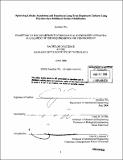| dc.contributor.advisor | Linda G. Griffith. | en_US |
| dc.contributor.author | Wu, Jonathan (Jonathan G.) | en_US |
| dc.contributor.other | Massachusetts Institute of Technology. Dept. of Mechanical Engineering. | en_US |
| dc.date.accessioned | 2007-03-12T17:43:58Z | |
| dc.date.available | 2007-03-12T17:43:58Z | |
| dc.date.copyright | 2006 | en_US |
| dc.date.issued | 2006 | en_US |
| dc.identifier.uri | http://hdl.handle.net/1721.1/36682 | |
| dc.description | Thesis (S.B.)--Massachusetts Institute of Technology, Dept. of Mechanical Engineering, 2006. | en_US |
| dc.description | Includes bibliographical references (leaves 36-37). | en_US |
| dc.description.abstract | Hepatocyte morphology is known to be closely linked to cellular functions. As a result, morphogenesis is extremely important to attain organ-equivalent levels of tissue function from in vitro cultures. Thus, a challenge exists in designing materials suitable for supporting liver-derived cells that are not only biochemically hepatospecific but also biophysically sensitive to the mechanical nature of hepatocytes to achieve highly differentiated cell phenotype found in a natural liver. We employ a unique substrate material system of polyelectrolyte multilayers (PEM) that can be tuned to achieve mechanical compliances of several orders of magnitudes (Es = 105 to Es = 108 Pa). We have shown that PEM modification can effectively change the surface mechanical compliance, and, thus, hepatocyte morphology and attachment, by looking at varying PEM pH deposition conditions (pH 2.0, 4.0, and 6.5) and collagen concentrations (0, 3, 10 ug/cm ) on different materials (tissue-culture polystyrene, polycarbonate, and Permanox). For all materials, PAH/PAA 4.0/4.0 provided the balance of cellular attachment that appeared neither confluent nor sparse while also promoting a natural hepatocyte phenotype. | en_US |
| dc.description.abstract | (cont.) We also observed that PEM films can effectively mask any inherent substrate material properties. Therefore, the use of PEM modification can be applied to a variety of surfaces and geometries for hepatocyte cultures. We believe that PEM is an invaluable tool in optimizing cellular attachment and function and will prove to be essential to future in vitro hepatocyte studies. | en_US |
| dc.description.statementofresponsibility | by Jonathan Wu. | en_US |
| dc.format.extent | 38 leaves | en_US |
| dc.language.iso | eng | en_US |
| dc.publisher | Massachusetts Institute of Technology | en_US |
| dc.rights | M.I.T. theses are protected by copyright. They may be viewed from this source for any purpose, but reproduction or distribution in any format is prohibited without written permission. See provided URL for inquiries about permission. | en_US |
| dc.rights.uri | http://dspace.mit.edu/handle/1721.1/7582 | |
| dc.subject | Mechanical Engineering. | en_US |
| dc.title | Optimizing cellular attachment and function in long-term hepatocyte cultures using polyelectrolyte multilayer surface modification | en_US |
| dc.type | Thesis | en_US |
| dc.description.degree | S.B. | en_US |
| dc.contributor.department | Massachusetts Institute of Technology. Department of Mechanical Engineering | |
| dc.identifier.oclc | 77536773 | en_US |
